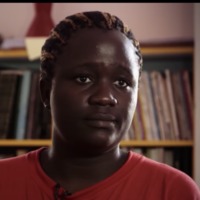
Nora
There are an estimated 145,000 people liing in conditions of modern slavery in Italy (GSI 2018). Italy is a destination, transit, and source country for women, children, and men subjected to sex trafficking and forced labour. Victims originate from Nigeria, Romania, Morocco, China, and other countries. Female victims are often subjected to sex trafficking in Italy after accepting promises of employment as dancers, singers, models, restaurant servers, or caregivers. Romanian and Albanian criminal groups force Eastern European women and girls into commercial sex. Nora’s family was poor and constantly worrying how to make ends meet. One day she met a woman who told her she could arrange a job for her abroad in Europe. Nora thought this was an opportunity to support her family and agreed. Before leaving Nigeria, she and others were required to go through a voodoo ceremony and swear an oath to pay back the woman for travel costs. The route went through Niger and Libya, as soon as they left Nigeria, the woman’s attitude changed. Nora and the other women she travelled with were trafficked into prostitution and forced to work in brothels along their journey in Niger, Libya, and Italy.

Arunny
There are an estimated 261,000 people living in modern slavery in Cambodia (GSI 2018). All of Cambodia's 25 provinces are sources for human trafficking. Cambodian women and girls move from rural areas to cities and tourist destinations where they are subjected to sex trafficking in brothels, beer gardens, massage parlors and salons. Cambodian men form the largest source of demand for children exploited in prostitution, although men from across the world travel to the country to engage in child sex tourism. Arunny* was trafficked for commercial sexual exploitation at the age of twelve in Cambodia.

Mark Ovenden
The Global Slavery Index 2018 estimates that on any given day in 2016, an estimated 3.6 million men, women and chidlren were living in modern slavery in Europe and Central Asia (GSI 2018). People are subjected to exploitation in forced labour, debt bondage and forced sexual exploitation. Government response in Europe is particularly strong with a number of regional bodies holding them account and monitoring responses, and while countries in Central Asia have taken steps to tack modern slavery, more needs to be done. Mark was unemployed and looking for work when he was offered a job and a place to stay. However, he soon found himself trafficked into forced labour. He worked long hours doing laborious work and was not paid. He was trafficked in the UK, the Netherlands and Sweden.

Bella
There are an estimated 261,000 people living in modern slavery in Cambodia (GSI 2018). All of Cambodia's 25 provinces are sources for human trafficking. Cambodian women and girls move from rural areas to cities and tourist destinations where they are subjected to sex trafficking in brothels, beer gardens, massage parlours and salons. Cambodian men form the largest source of demand for children exploited in prostitution, although men from across the world travel to the country to engage in child sex tourism. Bella is from Phnom Penh, Cambodia. She was trafficked for commercial sexual exploitation at the age of 12. Bella was able to find refuge in a faith-based organization.

Jana
There are an estimated 5,000 people living in modern slavery in Slovenia (GSI 2018). Traffickers exploit foreign workers and undocumented migrants vulnerable to labour trafficking in forced begging, domestic servitude, and in construction, transportation, and hospitality. Women and children from Slovenia, Eastern European, Western Balkan, Southeast Asian, and Latin American countries to sex trafficking within Slovenia, and many also transit to Western Europe, primarily Italy and Germany, where they are at risk of sexual and labour exploitation. Ethnic Roma are particularly vulnerable to trafficking in Slovenia. Jana was trafficked at the age of 13 in Slovenia by a friend who had arranged a job interview for her. During the interview she was kidnapped, raped and forced into prostitution.

Bianca
There are an estimated 403,000 people living in modern slavery in the United States (GSI 2018). Sex trafficking exists throughout the country. Traffickers use violence, threats, lies, debt bondage and other forms of coercion to compel adults and children to engage in commercial sex acts against their will. The situations that sex trafficking victims face vary, many victims become romantically involved with someone who then forces them into prostitution. Others are lured with false promises of a job, and some are forced to sell sex by members of their own families. Victims of sex trafficking include both foreign nationals and US citizens, with women making up the majority of those trafficked for the purposes of commercial sexual exploitation. In 2015, the most reported venues/industries for sex trafficking included commercial-front brothels, hotel/motel-based trafficking, online advertisements with unknown locations, residential brothels, and street-based sex trafficking. Bianca began speaking to a man she had met online and when she turned sixteen, she left home and travelled to see him. She went to Vegas where the man trafficked her into prostitution. He threatened to kill anyone that tried to take her home and forced Bianca to start taking drugs. She was finally able to leave and later heard that he had been arrested.

Mina S.
There are an estimated 61,000 people living in modern slavery in Saudi Arabia (GSI 2018). It is a source and destination country for men and women trafficked from South and South East Asia and Africa. People voluntarily migrate to the country to work in a variety of sectors including construction and domestic service; many of these workers are vulnerable to forced labour. Traffickers and brokers often illegally recruit migrants to work in Saudi Arabia and subsequently forced them into domestic servitude or debt bondage. Female domestic workers are particularly at risk of trafficking due to their isolation inside private residences. Non-payment or late payment of wages remains a complaint from foreign workers, while employer's withholding of worker's passports remains a significant problem. Trafficking perpetrators include businesses of all sizes, private families, recruitment companies in both Saudi Arabia and labor-sending countries, and organized criminal elements. Mina S., an Indonesian domestic worker travelled to Saudi Arabia for work. She was forced to work long hours without pay and was beaten by her employer. Mina was locked in the house and had to escape through a ventilation hole in the bathroom.

Albert
There are an estimated 794,000 people living in conditions of modern slavery in Russia (GSI 2018). Forced labour remains the predominant form of human trafficking in the country. Labour trafficking has been reported in the construction, manufacturing, logging, textile, and maritime industries, as well as in sawmills, agriculture, sheep farms, grocery and retail shops, restaurants, waste sorting, street sweeping, domestic service, and forced begging. Many migrant workers experience exploitative labour conditions characteristic of trafficking cases, such as withholding of identity documents, non-payment for services rendered, physical abuse, lack of safety measures, or extremely poor living conditions. Albert*, A 17-year-old man from Novosibirsk in Russia was kidnapped and coerced into construction work. For six months he worked long hours under constant supervision and the threat of violence.

Indrani P.
There are an estimated 61,000 people living in modern slavery in Saudi Arabia (GSI 2018). It is a source and destination country for men and women trafficked from South and South East Asia and Africa. People voluntarily migrate to the country to work in a variety of sectors including construction and domestic service; many of these workers are vulnerable to forced labour. Traffickers and brokers often illegally recruit migrants to work in Saudi Arabia and subsequently forced them into domestic servitude or debt bondage. Female domestic workers are particularly at risk of trafficking due to their isolation inside private residences. Non-payment or late payment of wages remains a complaint from foreign workers, while employer's withholding of worker's passports remains a significant problem. Trafficking perpetrators include businesses of all sizes, private families, recruitment companies in both Saudi Arabia and labor-sending countries, and organized criminal elements. Sri Lankan domestic worker Indrani P. thought she was travelling to Dubai for work. Instead an agent took her to Riyadh where her employers beat and threatened her daily and withheld her salary.

Jayanadani A.
There are an estimated 61,000 people living in modern slavery in Saudi Arabia (GSI 2018). It is a source and destination country for men and women trafficked from South and South East Asia and Africa. People voluntarily migrate to the country to work in a variety of sectors including construction and domestic service; many of these workers are vulnerable to forced labour. Traffickers and brokers often illegally recruit migrants to work in Saudi Arabia and subsequently forced them into domestic servitude or debt bondage. Female domestic workers are particularly at risk of trafficking due to their isolation inside private residences. Non-payment or late payment of wages remains a complaint from foreign workers, while employer's withholding of worker's passports remains a significant problem. Trafficking perpetrators include businesses of all sizes, private families, recruitment companies in both Saudi Arabia and labor-sending countries, and organized criminal elements. Jayanadani A. was trapped in domestic servitude in Saudi Arabia. She explains her husband’s reaction upon finding out she had been raped and impregnated by her Saudi employer.

Shanika R.
There are an estimated 61,000 people living in modern slavery in Saudi Arabia (GSI 2018). It is a source and destination country for men and women trafficked from South and South East Asia and Africa. People voluntarily migrate to the country to work in a variety of sectors including construction and domestic service; many of these workers are vulnerable to forced labour. Traffickers and brokers often illegally recruit migrants to work in Saudi Arabia and subsequently forced them into domestic servitude or debt bondage. Female domestic workers are particularly at risk of trafficking due to their isolation inside private residences. Non-payment or late payment of wages remains a complaint from foreign workers, while employer's withholding of worker's passports remains a significant problem. Trafficking perpetrators include businesses of all sizes, private families, recruitment companies in both Saudi Arabia and labor-sending countries, and organized criminal elements. Shanika R., a Sri Lankan domestic worker, travelled to Saudi Arabia for work but was trafficked into domestic servitude. When she requested her salary, her employer shaved her head. She was subjected to physical violence and threats.

Sandra C.
There are an estimated 61,000 people living in modern slavery in Saudi Arabia (GSI 2018). It is a source and destination country for men and women trafficked from South and South East Asia and Africa. People voluntarily migrate to the country to work in a variety of sectors including construction and domestic service; many of these workers are vulnerable to forced labour. Traffickers and brokers often illegally recruit migrants to work in Saudi Arabia and subsequently forced them into domestic servitude or debt bondage. Female domestic workers are particularly at risk of trafficking due to their isolation inside private residences. Non-payment or late payment of wages remains a complaint from foreign workers, while employer's withholding of worker's passports remains a significant problem. Trafficking perpetrators include businesses of all sizes, private families, recruitment companies in both Saudi Arabia and labor-sending countries and organized criminal elements. Sandra C. travelled to Saudi Arabia from the Philippines for work through a recruiter. She was forced to work long hours with no days off. She was only paid for five months despite working for her employer for three years. When Sandra asked to return to the Philippines, her employer threatened to put her in jail and refused to give her an exit visa or her passport.

Fathima S.
There are an estimated 61,000 people living in modern slavery in Saudi Arabia (GSI 2018). It is a source and destination country for men and women trafficked from South and South East Asia and Africa. People voluntarily migrate to the country to work in a variety of sectors including construction and domestic service; many of these workers are vulnerable to forced labour. Traffickers and brokers often illegally recruit migrants to work in Saudi Arabia and subsequently forced them into domestic servitude or debt bondage. Female domestic workers are particularly at risk of trafficking due to their isolation inside private residences. Non-payment or late payment of wages remains a complaint from foreign workers, while employer's withholding of worker's passports remains a significant problem. Trafficking perpetrators include businesses of all sizes, private families, recruitment companies in both Saudi Arabia and labor-sending countries and organized criminal elements. Fathima S. travelled from Sri Lanka to Saudi Arabia for domestic work through an agent. She worked for a woman who consistently found fault with her work. Her employer called the recruitment agency who threatened to beat Fathima if she did not work to her employer’s satisfaction. Fathima asked for a new employer but was denied and was forced to continue working long hours for inadequate pay.

Haima G.
There are an estimated 61,000 people living in modern slavery in Saudi Arabia (GSI 2018). It is a source and destination country for men and women trafficked from South and South East Asia and Africa. People voluntarily migrate to the country to work in a variety of sectors including construction and domestic service; many of these workers are vulnerable to forced labour. Traffickers and brokers often illegally recruit migrants to work in Saudi Arabia and subsequently forced them into domestic servitude or debt bondage. Female domestic workers are particularly at risk of trafficking due to their isolation inside private residences. Non-payment or late payment of wages remains a complaint from foreign workers, while employer's withholding of worker's passports remains a significant problem. Trafficking perpetrators include businesses of all sizes, private families, recruitment companies in both Saudi Arabia and labor-sending countries and organized criminal elements. Haima G. travelled to Saudi Arabia for work to help her family. Relatives deceived Haima G. about her promised job abroad. Her agent sexually harassed her, and her employer threatened to return her to her abusive agent if she complained. Her employer sexually assaulted her, retained her passport, and locked her in the workplace so that she could not escape.

Marcela Loaiza (Narrative 2)
There are an estimated 37,000 people living in modern slavery in Japan (GSI 2018). The country is the destination for men, women and children trafficked for forced labour and commercial sexual exploitation. The majority of trafficking victims are foreign women who migrate willingly seeking work but find themselves trapped in debt bondage, having to work in domestic and sex work to pay off fees incurred. Despite warning from the U.N., it is reported that human trafficking is on the rise in Japan. Marcela Loaiza was 21 years old when she was lured from Colombia, trapped in a sex trafficking ring, and forced by Japan’s Yakuza mafia to sell sex on the streets of Tokyo. After 18 months of sexual exploitation, she escaped, so ill that her hair and teeth were falling out. Today Loaiza, 35, runs a non-governmental organisation that bears her name to raise awareness about human trafficking among girls, women and men in Colombia and the United States, where she now lives. Loaiza spoke with Thomson Reuters Foundation by telephone from the Colombian city of Cali and recalled how she escaped forced prostitution and the mafia, and how she moved past the pain and guilt and healed.

Jessie
There are an estimated 10,000 people living in modern slavery in Lebanon (GSI 2018). Human traffickers exploit domestic and foreign people in Lebanon, and people from the country abroad. Women and girls from South and Southeast Asia and an increasing number from East and West Africa are subjected to domestic servitude in Lebanon. Lebanese government officials and NGOs report most employers withhold their workers passports, putting them at risk of trafficking. NGOs also report that abuse of domestic is underreported. Many migrant workers arrive in Lebanon through legal employment agencies, but are subsequently exploited or abused by their employers; some employment agencies recruit workers through fraudulent or false job offers. Jessie travelled from Kenya to Lebanon to take up employment as a domestic worker. She was subjected to long hours and sexual harassment from her employer. One day she finally decided to escape, tying bed sheets together and climbing out the window.

Raymundo
There are an estimated 403,000 people living in conditions of modern slavery in the United States (GSI 2018). The US attracts migrants and refugees who are particularly at risk of vulnerability to human trafficking. Trafficking victims often responding to fraudulent offers of employment in the US migrate willingly and are subsequently subjected to conditions of involuntary servitude in industries such as forced labour and commercial sexual exploitation. Raymundo travelled from Mexico to California for work. He was promised it would be legal and took out a loan from his trafficker to pay for his visa. Upon arrival, he was forced to live in a room with 34 other men who had been trafficked. Raymundo was forced to work long hours under constant surveillance and threats of deportation. Raymundo was able to escape after approaching an inspector that had come to assess the farm.

Francis Bok (Narrative 2)
There are an estimated 465,000 people living in modern slavery in Sudan (GSI 2018). Traffickers exploit foreign and domestic victims in the country. Migrant children from West and Central Africa are exploited in forced labour for begging, public transportation, large markets and sex trafficking. Business owners, informal mining operators, community members and farmers exploit children working in brick making factories, goldmining, collective medical waste, street vending and agriculture. Children are exposed to threats, physical and sexual abuse, as well as hazardous working conditions and limited access to education or health services. At the age of four Francis Bok was kidnapped from a local market in South Sudan and forced into domestic slavery in northern Sudan. For 10 years he was forced to work long hours with no rest, treated like an animal by the family he worked for. Bok tried to escape twice before was finally being successful, reaching a refugee camp in Egypt. After a while in the camp he was able to get refugee status in the United States. In 2011 Francis Bok returned to South Sudan and works as a public relations manager at a construction company.

Rahat
There are an estimated 1.22 million people living in conditions of modern slavery in Indonesia (GSI 2018). Traffickers exploit both domestic and foreign victims in Indonesia. Government regulations allow employers in certain sections, including small and medium enterprises and labour-intensive industries, an exemption from minimum wage requirement, thus increasing risks of exploitation. Traffickers exploit many Indonesians through force and debt-coercion. Men, women and children are exploited in fishing, construction, on plantations, in mining and in manufacturing industries. Vessel crew on board Chinese, Korean, Vanuatuan, Taiwan, Thai, Malaysian and Philippines-flagged and/or owned fishing vessels operating in Indonesian waters subject fisherman to forced labour. Recruitment agencies lure people with promises of high wages, charge fees, assign them fake identities and labor permit documents and send them to fish long hours in waters on vessels operating under complex multinational flagging and ownership arrangements. Crews on board fishing vessels have reported low or unpaid salaries and coercive tactics such as contract discrepancies, document retention, restricted communication, poor living and working conditions, threats of violence and physical and sexual abused. Rahat was looking for work when he was encouraged by a friend to travel to Bangkok for work. He was told he would be able to make more money at sea than on land, however instead he was trafficked on to a fishing trawler in Indonesia. Conditions on the boat were awful, there was not enough food to last the crew and they were subjected to beating if they were ‘lazy.’

Shamere McKenzie (Narrative 2)
There are an estimated 403,000 people living in modern slavery in the United States (GSI 2018). Sex trafficking exists throughout the country. Traffickers use violence, threats, lies, debt bondage and other forms of coercion to compel adults and children to engage in commercial sex acts against their will. The situations that sex trafficking victims face vary, many victims become romantically involved with someone who then forces them into prostitution. Others are lured with false promises of a job, and some are forced to sell sex by members of their own families. Victims of sex trafficking include both foreign nationals and US citizens, with women making up the majority of those trafficked for the purposes of commercial sexual exploitation. In 2015, the most reported venues/industries for sex trafficking included commercial-front brothels, hotel/motel-based trafficking, online advertisements with unknown locations, residential brothels, and street-based sex trafficking. Shamere McKenzie came to the US from Jamaica when she was 6 years old. A talented track star, she was running at college level when she injured her hamstring. With her scholarship in jeopardy, she met someone who said they could help her return to school, all she had to do was dance at his nightclub. One evening, however, Shamere was taken to a house in Brooklyn where she was told to have sex with a customer. When she refused, her trafficker threatened her life, and when she tried to leave when they returned home he beat her to unconsciousness. For eighteen months Shamere McKenzie was forced in to prostitution and trafficked across five different states under constant threats of violence. She finally escaped when her trafficker allowed her to call her mother and she was able to get a flight back to New York.